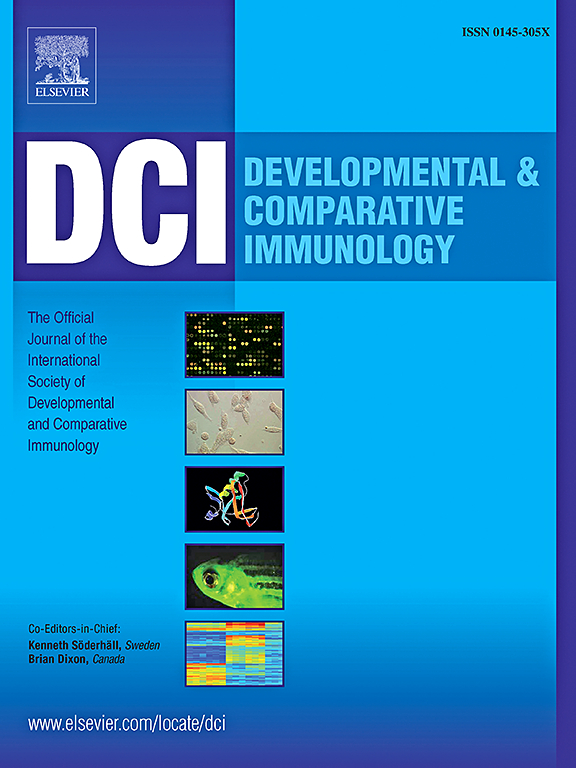Transcriptomic and microbiome analyses of copepod Apocyclops royi in response to an AHPND-causing strain of Vibrio parahaemolyticus
IF 2.7
3区 农林科学
Q1 FISHERIES
引用次数: 0
Abstract
Copepods are small crustaceans that live in microorganism-rich aquatic environments and provide a key supply of live food for fish and shellfish larviculture. To better understand the host-pathogen interaction between the copepod and Vibrio parahaemolyticus causing acute hepatopancreatic necrosis disease (VPAHPND), the comparative transcriptome and microbiome analyses were conducted in copepod Apocyclops royi-TH following VPAHPND infection. Transcriptome analysis identified a total of 836 differentially expressed genes, with 275 upregulated and 561 downregulated genes. Subsequent analysis showed that a total of 37 differentially expressed genes were associated with the innate immune system, including 16 upregulated genes related to Toll-like receptor signaling pathway, antimicrobial peptides, and stress response genes, and 21 downregulated genes associated with immunological modulators, signaling molecules, and apoptosis-related proteins. Analysis of the copepod microbiome following VPAHPND infection showed that the microbes changed significantly after bacterial infection, with a reduced alpha diversity accompanied by the increased level of Proteobacteria and decreased levels of Bdellovibrionota, Bacteroidota, and Verrucomicrobiota. The population of Vibrio genera were increased significantly, while several other genera, including Denitromonas, Nitrosomonas, Blastopirellula, Fusibacter, Alteromonas, KI89A_clade, and Ruegeria, were decreased significantly after infection. These findings suggest that VPAHPND infection has a significant impact on the immune defense and the composition of the copepod microbiota.
转录组和微生物组分析桡足类 Apocyclops royi 对引起 AHPND 的副溶血性弧菌菌株的反应。
桡足类是生活在微生物丰富的水生环境中的小型甲壳类动物,为鱼类和贝类幼鱼养殖提供了重要的活体食物。为了更好地了解桡足类与引起急性肝胰腺坏死病(VPAHPND)的副溶血性弧菌之间的宿主-病原体相互作用,研究人员对桡足类 Apocyclops royi-TH 感染 VPAHPND 后的转录组和微生物组进行了比较分析。转录组分析共发现了 836 个差异表达基因,其中上调基因 275 个,下调基因 561 个。随后的分析表明,共有 37 个差异表达基因与先天性免疫系统有关,其中 16 个上调基因与 Toll 样受体信号通路、抗菌肽和应激反应基因有关,21 个下调基因与免疫调节剂、信号分子和细胞凋亡相关蛋白有关。对感染 VPAHPND 后桡足类微生物组的分析表明,细菌感染后微生物组发生了显著变化,α 多样性降低,伴随着变形菌群水平的升高和 Bdellovibrionota、Bacteroidota 和 Verrucomicrobiota 水平的降低。弧菌属的数量在感染后显著增加,而其他几个菌属,包括 Denitromonas、Nitrosomonas、Blastopirellula、Fusibacter、Alteromonas、KI89A_clade 和 Ruegeria,在感染后显著减少。这些研究结果表明,VPAHPND 感染对桡足类的免疫防御和微生物群组成有重大影响。
本文章由计算机程序翻译,如有差异,请以英文原文为准。
求助全文
约1分钟内获得全文
求助全文
来源期刊
CiteScore
6.20
自引率
6.90%
发文量
206
审稿时长
49 days
期刊介绍:
Developmental and Comparative Immunology (DCI) is an international journal that publishes articles describing original research in all areas of immunology, including comparative aspects of immunity and the evolution and development of the immune system. Manuscripts describing studies of immune systems in both vertebrates and invertebrates are welcome. All levels of immunological investigations are appropriate: organismal, cellular, biochemical and molecular genetics, extending to such fields as aging of the immune system, interaction between the immune and neuroendocrine system and intestinal immunity.

 求助内容:
求助内容: 应助结果提醒方式:
应助结果提醒方式:


